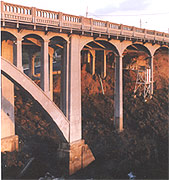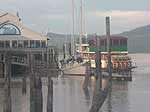 |
Published 02/03/09
Mini-Spring of February Hits Oregon Coast
 |
| February brings balmy temperatures to Seaside in 2004. |
(Oregon Coast) - It's becoming the stuff of legend as more and more Oregonians begin to catch on to what has been a bit of a secret.
And it's here on the coast right now, in all its balmy glory, making for 70-degree temperatures on some parts of the coast Tuesday.
Its sometimes nicknamed the "mini-spring" of February: those surprise stretches of warm weather on the coast that are becoming less of a surprise.
Wednesday should continue the warm temps, at least into the 60’s on the coast. See the Oregon Coast Weather page for more.
Portland isn't doing too badly as well, with clear skies and lovely temperatures, but the Oregon coast got almost toasty. Monday was also a banner day there.
The trend isn’t expected to last long. The forecast calls for some showers after Thursday, but temperatures during the day are expected to stay somewhat warm: in the 60’s and upper 50’s.
 |
| Depoe Bay |
Even those days are expected to be warmer than the valley, and the rain won’t be constant, making for altogether more pleasant conditions along the coastline.
This happens just about every year: six to ten days of extremely nice, spring-like weather on the beaches during February. They aren’t consecutive days – they’re scattered throughout the month – and this doesn’t always happen in great numbers each year. But in between the storms and the calmer rainy days, there’s often more than a sprinkling of blue skies and nice vibes in the winter than you’re probably aware of.
Lorna Davis, Tourism for the Newport Chamber of Commerce, said that “mini-summer” of February is really spectacular. “It’s always really weird,” she said. “It’s so warm. There’s always about six days of really banner, balmy weather in February. Then you can turn around and have a half a foot of snow in early March.”
 |
| Newport's Yaquina Bay on a warm February day. |
There’s more than a little science behind it, too.
KATU-TV meteorologist Rod Hill said this is not all that unusual, except
that on the coast, the moderate climate element can heighten the glorious
weather factor.
“In fact, a lot of areas of the country have that,” Hill said.
“By this time, you’ve gone through the early sunsets, dark
days and the wettest three months of the year. February is over that hump.
“The days are have been getting longer for five weeks and you’ve added enough daylight hours so that the weather is warmer. You get that much daylight increase and you start to get a climate shift.”
When those clear days of late happen – and it’s not all the time, that’s for certain – they’re colder in the valley because of the east winds bringing colder air. Basically, cold air settles in the valley. But on the coast, weather is automatically more moderate because it’s next to the ocean, which is about 50 degrees, keeping things from straying too far away from that temperature. Because of this you get a lot of days on the coast more around 50 in the winter, while the valley regions are much colder and more winter-like. In the summer, this same dynamic keeps the temperature down.
 |
| Just north of Florence on a balmy day in February, 2007. |
The coast range also blocks the cold air dynamics from the east, helping to keep the moderate temps trapped by the seashore.
Statistics also back this up – just look at an almanac that displays weather averages for the coast and the valley. These indicate a trend throughout the whole winter that shows the Oregon coast often getting less rain than the valley.
The myth about the coast always having more rain is one that is overdue to be busted.
One almanac statistic you’ll find says that the average percentage of cloudy days in Astoria in the month of January is 66 percent – meaning 66 percent of days in January were cloudy and not so nice in Astoria. Yet in Portland, the average is 68 percent of days in January were cloudy.
The average for Portland in December was 70 percent cloudy conditions through the month, while the north coast experience only 64 percent of those kinds of days. February was a dead tie at 63 percent. While that’s no surprise to any amateur or professional weatherman, other statistics show the coastal region as being much warmer in February.
 |
| Cape Meares |
Weather data collected over the years by the Hatfield Marine Science Center also backs this up. It fortifies another bit of local wisdom about weather trends as well: things tend to get a little drier and nicer in winter until you get a host of really nice days in February.
According to the Hatfield's
web site, you can see an increase of pleasant days over the three
months.
If you look at February 2002, a total of eleven days had zero rain, and
four had .02 inches or less. Highest wind gusts on those days ranged from
19 to 30 mph, and temperatures on these days were generally in the low-
to mid-50's. Half the month was less than .02 inches of rain or less.
February of 2004 year continued the legend, with ten days mostly in the low 50's and less than .02 inches of rain. Winds were 20 mph or less on these days. Two days were about 60 degrees, however. Most of the other days had half an inch or less of rain.
 |
| Hug Point, near Cannon Beach, showing winter sand erosion on a lovely February day. |
“Every month brings really different weather,” Davis said. “It’s not just storms during winter and fall, but there are instances of glorious weather.
“It’s full of incredible opportunities. Like whale watching in winter. It might be crisp and cool, but it will be blue skies and the coast will be clear. You’ll have unencumbered travel. If there’s great weather predicted in summer, Newport’s population of 10,000 jumps to 30,000. But if the weather is nice in winter, you’ll just get some traffic. Tourists are looking for an authentic experience, and the coast has it this time of year. Besides, you’ll want to scoop up the lodging discounts and two-for-one specials.”
“It’s as typical as it is not typical, if that makes any sense. These days do happen. You just don’t know when.”
 |
|
Tradewinds Motel, Rockaway Beach. All rooms are immaculate and have TV’s, VCR’s and in-room phones w/ data ports. Oceanfronts have queen bed, a double hide-a-bed, kitchen, cozy firelog fireplace and private deck. Both types sleep up to four people. Others are appointed for a two-person romantic getaway, yet still perfect for those on a budget. Elaborate oceanfront Jacuzzi suite has two bedrooms, kitchen, double hide-a-bed, fireplace and private deck, sleeping as many as six. For family reunions or large gatherings such as weddings, some rooms can connect to create two-room and three-room suites. Some rooms pet friendly. 523 N. Pacific St., Rockaway Beach. (503) 355-2112 - 1-800-824-0938. www.tradewinds-motel.com |
 Inn
at Cannon Beach. Beautifully wooded natural setting at quiet south
end of Cannon Beach. Great during winter storms with a new book by
the fireplace – or when the sun is out for family fun and beach
strolling. Handsome beach cottage-style architecture. Lush flowering
gardens and naturalized courtyard pond. Warm, inviting guest rooms.
Continental buffet breakfast. Warm Cookies. Family and Pet Friendly.
Welcome gifts. Smoke-free. Complimentary Wireless Connectivity. Wine
and book signing events. 800-321-6304 or 503-436-9085. Hemlock At
Surfcrest, Cannon Beach, Oregon. www.atcannonbeach.com. Inn
at Cannon Beach. Beautifully wooded natural setting at quiet south
end of Cannon Beach. Great during winter storms with a new book by
the fireplace – or when the sun is out for family fun and beach
strolling. Handsome beach cottage-style architecture. Lush flowering
gardens and naturalized courtyard pond. Warm, inviting guest rooms.
Continental buffet breakfast. Warm Cookies. Family and Pet Friendly.
Welcome gifts. Smoke-free. Complimentary Wireless Connectivity. Wine
and book signing events. 800-321-6304 or 503-436-9085. Hemlock At
Surfcrest, Cannon Beach, Oregon. www.atcannonbeach.com. |
RELATED STORIES
Unusual Travel Articles TravelParanormal.com allows you to submit your own creepy tale or debunk one - or see up-to-the-minute news headlines about travel and the paranormal.
Watching Transformations of Oregon Coast Beaches Seasons change and so do beaches, revealing different sides and a variety of eye-popping sights
Staggeringly Cool Ideas for Oregon Coast Romance Be it the season of Valentine's or be it any time of the year, Oregon's coastline has essentially cornered the market for cuddle-inducing possibilities and gushy activities for the hand-holding set
Day or Night Mysteries and Merriment on Oregon Coast It's more than just nightlife that comes to life, but the beaches offer major opportunities
News Headlines from All Over Oregon Need to scan Oregon headlines? Constantly updated news from all over Oregon: a comprehensive, up-to-the-minute display of news headlines from a variety of media.
Lodging
Guide
|
|||||||||||||
OR
TAKE THE VIRTUAL TOUR |
|||||||||||||
|
Secrets of the Season |
|
The Ocean Lodge. There will not be another property built like this in Cannon Beach in our lifetimes. Rare, premiere ocean front location; handsome, dramatic architecture and tasteful, fun (nostalgic) beach interiors. Overlooks Haystack Rock. 100 percent smoke free. Imaginative special occasion packages. Massive wood burning lobby fireplace. Library w/ fireplace, stocked with impressive book collection. Pet and family friendly. Lavish continental buffet breakfast. In-room fireplaces, mini-kitchens. Jacuzzi tubs in select rooms. DVD players, complimentary movies. Morning paper. Warm cookies. 888-777-4047. 503-436-2241. 2864 Pacific Street. Cannon Beach, Oregon. www.theoceanlodge.com |
|
Arch
Cape Property Services.
Dozens of homes in that dreamy,
rugged stretch between Cannon Beach and Manzanita known as Arch
Cape. Oceanfront and ocean view , or just a short walk from the
sea. |
USFinanceNews.com Economic, Wall street, personal finance news, udpated constantly
CONTACT / ADVERTISE ON BEACH CONNECTION






































